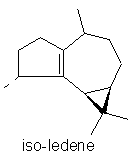

Ravensara Oils
Adapted from an article in
Aromatherapy Times 1(61), 12 (2004) by Tony Burfield.
Copyright © Tony Burfield Sept 2004.
Pre-amble.
The situation regarding the exact botanical identification of the source of Ravensara oil has previously confused some most learned and academic researchers (let alone aromatherapists!), and has been the subject of a number of articles. Sheppard-Hanger (1996)10 reviews the literature on Ravensara oils (14 references and much unpublished material) and Michel Vanhove also provides information on the history of Ravensara (Internet newsgroup “idma” communication 7.5.00) which is reproduced in an article by Burfield & Sorenson (1999).
Ravensara oil.
The Ravensara genus is included in the Cryptocarya within the Lauraceae family, representing a group of some two hundred species found in warm & tropical climes1. We need to distinguish between 3 endemic Madagascan species to take things further:
Ravensara aromatica Sonn.
Ravensara anisata Danguy et Choux
Cinnamomum camphora (L.) J. Presl
Ravensara aromatica was described in 1642 by de Flacourt and characterised in 1782 by Sonnerat, as aromatic tree growing to a height of 20m. at elevations of 700-1000m in humid evergreen forests in the East of the island with a few stands growing on the Eastern coasts. The tree has fragrant leaves, bark and nut, the anise-flavoured bark being used for local rum-making. Dangay described the species as R. anisata in 1925, based on its aniseed odour character, but Kostermans in 1950 characterised both species as the same plant.
The conservationist and essential oil trader Olivier Behrer2 repeats Rasoanaivo & De la Gorce’s (1998)3 findings, that Ravensare oil – which he spells with an “e” - from Ravensara aromatica - is really Agatophyllum aromaticum (Sonnerat) Willd. Behrer further provides an analysis showing the oil contains 3-6% of the methyl eugenol, which has been identified as a potent rodent carcinogen. He further maintains that Ravintsare oil – note different spelling - is derived from Cinnamomum camphora4. Ravintsara, by the way is a Malagasy word meaning “good leaves”.
Bark oils.
R. anisata listed above, is now considered synonymous with R. aromatica according to Rosoanaivo (1997)8 & Rasoanaivo & De la Gorce (1998)3 and the composition of the stem & bark oils of R. aromatica is confirmed as containing 90% methyl chavicol8. This is at variance with the findings of S. Mollinbeck et al. (1997)5 who found methyl eugenol to be the main component, but is in agreement with D. de Medici et al (1992)6 who again found up to 90% methyl chavicol as the main component of R. anisata oils7. However Franchomme & Peneol (1995) unhelpfully regarded R. anisata and R. aromatica as two distinct species.
Leaf oils.
However it is the Ravensara leaf oils from Madagascar, or perhaps Mauritius, which are invariably sold by aromatherapy e.o. sellers. This is can be steam distilled from the heavily exploited evergreen tree ‘havozo’: Ravensara aromatica (syn. Agatophyllum aromaticum as discussed above) and is principally composed of the monoterpene hydrocarbons a-pinene, sabinene, myrcene, limonene, & the azulene: iso-ledene.


However an introduced species of Cinnamomum camphora from Formosa is also confusingly called “ravensara” by oil sellers, and even worse, is often incorrectly described as Ravensara aromatica, and it is this species which corresponds to Behrer’s “Ravintsara” above. As the plant has become adapted to the Malagasy climate, it has lost the ability to produce camphor, and the oil is mainly composed of sabinene (13-15%) and over 50% of 1,8-cineol. This Malagasy oil is (or certainly should be) a different oil to the White Camphor oil (Cinnamomum camphora) of commerce, which is invariably the front distillation fractions of White Camphor oil Chinese (cineol type).
Threatened Status.
Rosoanaivo (1997)8 describes Ravensara aromatica as a rare aromatic plant and describes one Malagasy company that exports 1 ton of essential oils of R. aromatica stem bark. The total amount of stem bark destructively harvested is estimated by the author at 100 tons per year. Collection of bark to distil these bark oils is injuring and so threatening the ecological status of the tree in Madagascar, and is hopefully being discouraged by the Forestry Department. However there is no clear indication to Cropwatch that this is effectively happening.
Conclusions.
Sorry this is so complex, but if you just walk away
with the idea that commercially traded Ravensara oils are generally either
distilled from the leaves of R. aromatica or a naturalised C.
camphora species, then you are not going far wrong. I discuss further
complexities and Lawrence’s suggestion of chemotypes9 for R.
aromatica in my book7 but lets leave it there for now!
References
See also:
Andiantsiferana et al. (1995) “Chemical Analysis of Essential Oils of Malagasy endemic species: Piper sp. Ravensara anisata Danguay and Ravensara aromatica Sonnerat” American Society of Pharmocognosy July 23-27 1995 through Lis-Balchin M. (1996) International J. Aromatherapy 7(3).
Holm Y & Hiltunen R. (1999) “Chemical Composition of a Commercial Oil of R. aromatica Sonn. Used in Aromatherapy.” J. Essent. Oil Res. 11, 677-678.
Théron E. et al. (1994) “Authentication of Ravensara aromatica and Ravensara anisata.” Planta Med., 60, 489-491, 1994.
Tucker A.O. and Maciarello M.J “Two commercial oils of Ravensara from Madagascar: R. anisata and R. aromatica.” J. Essent. Oil. Res., 7, 327-329.